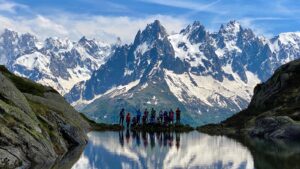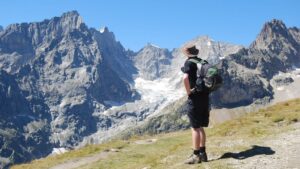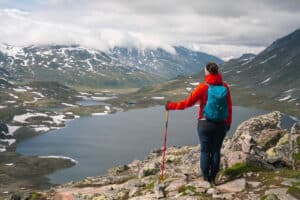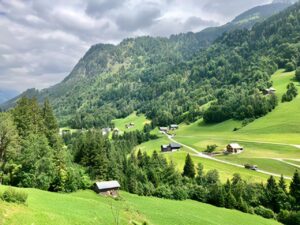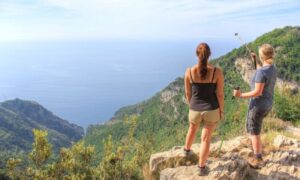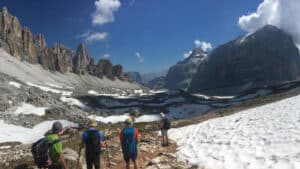Choose your trek
Select your trek and check availability, either by phoning us or sending an on-line enquiry.

We make good use of cable cars to gain height quickly, allowing us to trek in the high Dolomites with far-reaching views. You’ll cover 130km over 9 hiking days, with significant ascents and descents. Our route follows quieter trails, staying in a mix of 3-star hotels and charming family-run refuges. With luggage transfers, all transport and most meals included, you can focus on enjoying this spectacular mountain journey.
Challenging+
Regional specialties with Italian and Austrian influences
Enjoy a mix of comfortable hotels and private mountain refuges
Experienced International Mountain Leaders
Minimum 6 / Maximum 14 people
All scheduled treks will run with our minimum group size
A west-east traverse through the best of the Dolomites.
Meet at Venice Marco Polo Airport at 13:00 hrs (1 pm). Your Guide will meet you by red-fronted RELAY shop in the Arrivals Hall at Venice Marco Polo Airport. Please note that it can be extremely busy by the main exit from the luggage area.
We will then transfer you by road to our hotel in Alpe di Siusi. The trip takes 3.5 to 4 hours. Alpe di Siusi is a vast meadow at an altitude of 1850m and Europe’s largest mountain plateau at 55 km², offering spectacular views. We stay in a hotel located in the centre of Compaccio village.
Enjoy excellent views of the Sasso Piato mountain, Catinaccio range, and the Seiser Alm plateau.
Today, we make good use of the lift system to quickly gain altitude and hike across a spectacular rocky plateau resembling a lunar landscape.
From Sass de Pordoi we hike for approximately 90 minutes crossing some rough ground to the Rifugio Boè which sits beneath the Piz Boè mountain. We can stop here for coffee and cake in this modern eco-building. There are spectacular views, including the famous Marmolada - the highest peak in the Dolomites, known as the ‘Queen of the Dolomites’.
Descend on the same cable car back to Sass de Pordoi, then head down to the charming town of Arabba (1600m).
After breakfast, We take a short transfer and lift up to 2000m.
This region was witness to the first vertical war in history during the First World War and we see where the soldiers fought.
Today is a rest day. Cortina is the premier ski resort in Italy frequented by Europe’s jet-set crowd.
Cortina is a pretty town located in a valley surrounded by mountains with the Boite River running through it.
You are free to explore this upmarket town with its swanky shops, cafés and restaurants. There are a couple of small museums focusing on modern art, the Great War and Paleontology.
You can also make an excursion by public bus to visit the tunnel system made during the First World War.
We take a bus ride from Cortina heading towards the Tre Cime and pass by the famous Rifugio Auronzo (2320m).
A shorter day amongst magnificent surroundings.
Our final day’s hike allows us to savour the steep cliffs and lakes of this unique mountain range.
After breakfast, we transfer in 3 hours to Venice Marco Polo Airport by private minibus. We aim to arrive by 13:00 hrs (1pm).
This map is for illustrative purposes only.
The route is approximately 130km/81 miles. This trip should appeal to you if you regularly take walking weekends and are happy covering 15-21km (10-14 miles) each day, with a number of ascents and descents over varying terrain. On this trek in the Dolomites we normally walk for between 6 and 8 hours each day and be outdoors for 8 or 9 hours. We generally follow good paths that are well-travelled, but they are not maintained by a park authority. You will encounter uneven paths, rocky steps, rocks underfoot and occasional tree roots on the trail. On some short sections, we will encounter fixed equipment, such as cables for hand lines and short ladders. These are normal in the Dolomites and our route only follows established hiking trails. Please note that we do not follow the via ferratas or scrambling routes which are a step-up from hiking and require specialist equipment.
The Dolomites Traverse is a challenging trek suitable for fit hikers with previous experience doing challenging multi-day hikes in the mountains. Typical days involve:
The Dolomites Traverse is a bit more strenuous than the Tour du Mont Blanc, with longer days, more ascent/descent, and three refuge nights without access to your main luggage.
The terrain itself is not highly technical - hiking boots are sufficient and no climbing or gear is needed - but it is more rugged than many popular trails in the Alps.
Our Dolomites Traverse is graded 4 (Challenging+), a step up from the TMB in difficulty. The hiking days are longer, the elevation gains/losses are greater, and the terrain is rougher than on many other well-known Alpine treks.
Days are typically 7-8 hours on the trail, with daily ascents/descents of 800-1500m. You'll cover 16-20km per day, hiking at altitudes between 1000-3200m. The terrain is varied, ranging from well-travelled trails to rocky and uneven paths with rocky steps. There may be some small sections of fixed equipment, such as short ladders or handrails, but there are no long ladders or via ferrata. You need to be confident of your fitness.
As you will trek to higher altitudes the effect of any poor weather will bring cold wind and rain. Early-season treks may encounter old winter snow at the highest elevations and a ski pole is useful for balance. Ice axes and crampons are not necessary.
While you only need to carry a daypack, there are 3 nights (days 2, 5 and 9) without your main luggage so you'll need to carry your overnight essentials: spare underwear, socks, T-shirt and a few toiletries.
The 11-day Dolomites Traverse price includes:
In addition to the trek cost, you should budget for the following extra expenses:
Credit cards are widely accepted, but we recommend carrying about €100-150 in cash for small purchases. ATMs are available in the larger towns but not in the small villages or on the trail.
Having the right gear is important for this trip. The essentials include:
We strongly recommend being prepared and bring broken-in boots.
For the mountain refuge nights without access to your main luggage, you'll need to carry your backpack with essentials like clean base layers, spare socks and basic toiletries. The refuges provide blankets and pillows.
Hotels (7 nights)
Mountain Refuges (3 nights)
The hotels are mostly 3-star and have extras like on-site spas, saunas and bars.
The mountain inns or refuges offer more basic lodging in spectacular high-mountain settings.
All transport during your Dolomites tour is included. This comprises:
Arrival and departure transfers
Local transfers
The Venice transfer takes 3-4 hours each way in a private van. Local buses and lifts are all very short.
If you miss the airport transfer you should call us for information on how to get to the start of the trek: any costs incurred will be your responsibility. Please note that it is 4 hours by road to Alpe di Siusi: a taxi would be prohibitively expensive. You would need to transfer by public bus and/or train via Bolzano. You are welcome to arrange your own transport to the hotel in Alpe di Siusi, at your own expense.
Your main luggage is transferred between hotels.
Every morning, you'll leave your main bag at the hotel reception with a luggage tag we provide you. The bags are picked up and transferred in a van to your next accommodation.
For the nights when you stay at the mountain refuges (night 2, 5, 9) you will not have access to your main luggage and so you'll just need to pack a few overnight essentials (toiletries, change of underwear, socks and T shirt and a sheet sleeping bag for the refuge on night 9).
Luggage is limited to 1 bag per person, with a maximum weight of 15kg (33lbs). Please bring soft luggage like sports bags or backpacks. Bags should be clearly labeled with your name.
We highly recommend you do not pack any valuables (laptops, money etc) in your transferred luggage in the unlikely event of damage or theft. Luggage is generally transferred to each hotel's reception area. Keep your passport, wallet, phone, camera, and any medications with you in your daypack. Your main bag will not be accessible during the day.
The group transfer for this trek is from Venice Marco Polo Airport (VCE), where you'll meet your guide and fellow hikers. We'll gather at 1:00pm on Day 1 at the red-fronted RELAY shop in Arrivals.
It's about a 3.5 hour drive to Alpe di Siusi.
If you miss the group transfer, you'll need to make your own way to Alpe di Siusi at your expense (train/bus through Bolzano or expensive taxi).
Flying into Venice is relatively straightforward from many European and international hubs.
Departure: The group transfer drops off at Venice Marco Polo by 1pm on Day 11. If you need to arrive earlier for a flight, you'll need to book a private transfer (we can assist). Please don't book flights departing Venice before 3pm to ensure adequate time for check-in.
It is your responsibility to check your specific passport, visa and entry requirements and ensure you have the necessary documents for all countries on the trek. Regulations can change, so review the rules before you travel.
You should bring a copy of your insurance policy with emergency contact numbers. Leave a copy with someone back home.
The summer hiking season in the Dolomites runs from mid-June through late September. During this time, weather conditions are generally favourable for trekking, with warm to hot days. However, as with all mountain ranges it can rain - either as frontal weather or as thunderstorms after a hot day - and you should come prepared for this.
Temperature: Expect daytime highs of 20-30°C (68-86°F) in the valleys and 10-20°C (50-68°F) at higher elevations. Night temperatures dip down to 10-15°C (50-59°F), feeling colder at altitude.
It's essential to come prepared for a wide range of mountain weather, with layers that can be adjusted throughout the day.
Your guide will check the forecast daily and adjust the hiking plan if needed for safety and enjoyment.
Select your trek and check availability, either by phoning us or sending an on-line enquiry.
Complete an on-line booking form and pay a deposit of 20% of the tour.
Payments are in British Pounds (GBP). You can pay by bank transfer, credit or debit card.
Once the payment has been received we will send you an e-mail confirmation.
The 2024 Dolomites Traverse trip is confirmed for the following dates:
We did a self-guided route with Salamander booking all our well-organised hotels. The excellent Dolomites traverse offered varied landscapes and managed to avoid the worst crowds.
Trip notes very accurate good hotels and locations great walks my first time to dolomites my 4th trip with Nigel Lewis very good team leader thanks for great memories.
A great trek through the startling scenery of the Dolomites with a really nice group of people and well-led by Nigel.
Fantastic trip with great weather showcasing the Dolomite Mountains. Simon, our knowledgeable leader, made the history engaging. My second trip with Salamander - highly recommend them!
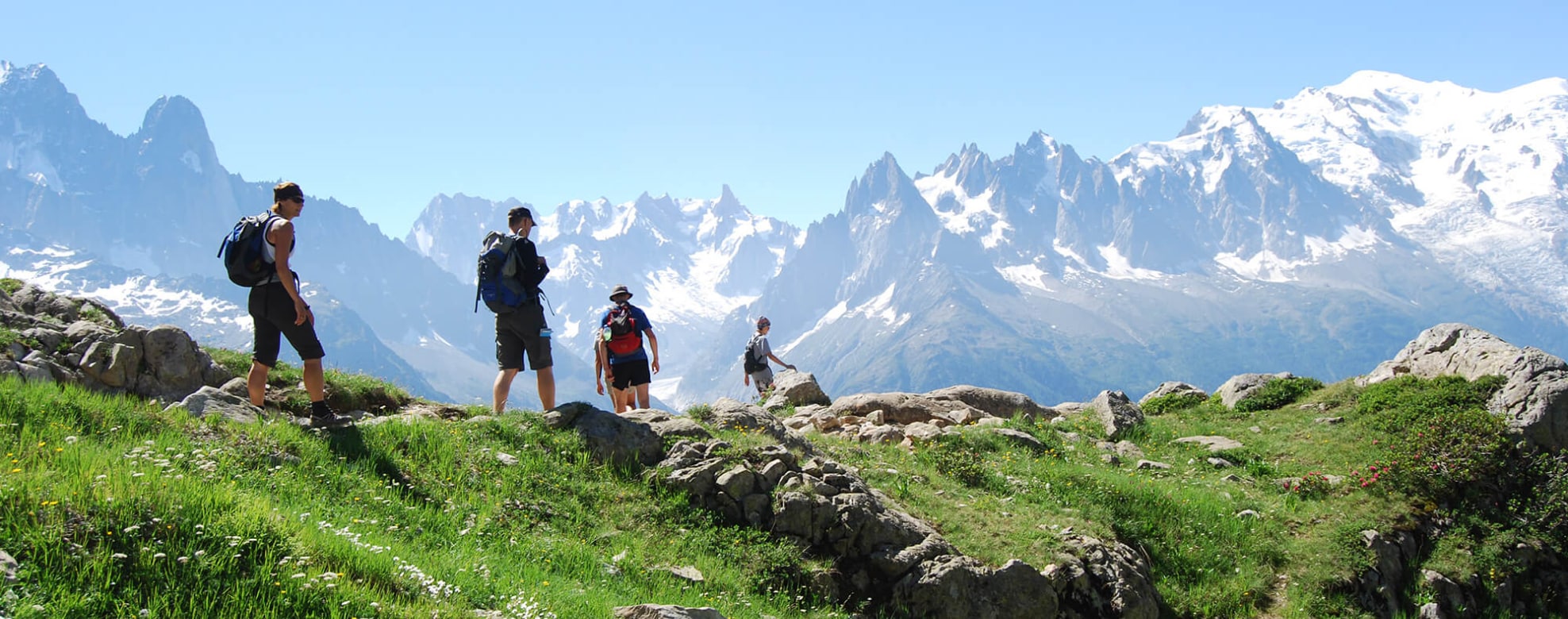
The Dolomites are an icon of northeastern Italy, known for their sublime beauty and incredible variety of landscapes. With UNESCO World Heritage status and three distinct cultures, this region offers so much more than just epic hiking.
View All Points of InterestA Mountain Refuge on the Dolomites Trek A Scenic Retreat in the Heart of the Dolomites Nestled at 1,985 metres within the Fanes-Senes-Braies Natural Park, Utia Scotoni is a renowned…
Learn moreIconic Peaks of the Dolomites Introduction to Tre Cime di Lavaredo Standing as the emblem of the Dolomites, the Tre Cime di Lavaredo, or "Three Peaks of Lavaredo," represent one…
Learn moreA Landmark on the Dolomites Traverse A Key Stop in the Dolomites Rifugio Alpe di Tires, located at an altitude of 2,440 metres, is a renowned mountain hut in the…
Learn moreA High-Altitude Highlight in the Dolomites Introducing Piz Boè on the Dolomites Trek Piz Boè, towering at 3,152 metres, is the highest peak in the Sella massif of the Dolomites.…
Learn moreA Unique Mountain Hut Experience on the Dolomites Trek An Iconic Refuge in the Dolomites Pian di Cengia, or Büllelejochhütte, is the highest and smallest mountain hut in the Sesto…
Learn moreReady to explore the world’s most stunning landscapes? Reserve your spot today!

You've got questions, we've got answers! Read on for insider tips and advice to make the most of your Dolomites trekking holiday.
The Dolomites Traverse is our most challenging Trek, best suited to hikers with significant mountain walking experience. You should be:
If you are new to trekking, we recommend starting with an introductory trip like the Tour du Mont Blanc. But if you have a strong hiking and endurance background (e.g. from a Grand Canyon rim-to-rim or climbing Mt Kilimanjaro), this could be a good fit. Contact us to discuss your ability level.
The ideal hiking footwear for the Dolomites is a sturdy boot with:
Brand-name boots we see frequently on the TMB include Scarpa, Lowa, Salomon, Asolo, La Sportiva, Vasque, Zamberlan, and Meindl. The key is to find a reputable boot that fits your foot well (both in length and width), with ample time to break them in before your trek.
Other footwear to consider:
Visit a specialty outdoor retailer to get fitted for boots. Ask the sales staff for advice based on your trek plans and foot shape. Wear the socks you plan to hike in when trying on boots, and shop near the end of the day when your feet are most swollen.
Once you buy boots, wear them on local training hikes to make sure they're the right choice. Go up and down hills, on uneven ground, and in wet conditions. This will help you determine the ideal sock combination and lacing for your feet.
The Dolomites Traverse follows a patchwork of local trails rather than a single famous route. This allows us to maximize scenery and visit the region's most charming villages and rifugios.
Expect a mix of:
Most days involve significant climbing and descent. You'll definitely feel it in your legs! Trekking poles are a must for saving your knees.
Trails are generally well-marked with painted waymarks and signposts at junctions. However, they aren't maintained to the standard of national park paths in some countries. It can be rocky, slippery, or exposed in parts.
That's where your guide comes in - to keep you on route, set a good pace, and teach you techniques for efficiency and stability on the trail. They'll show you how to use fixed aids like cables and ladders safely. By the end of the trek, your mountain confidence will have grown immensely.
You'll carry a daypack of about 30-35 liters with everything you need while hiking, such as:
On the days/nights you're staying in mountain refuges (total 3), you'll need to carry a bit more for the overnights, including:
This will make your pack about 5-7kg (10-15lbs). The exact weight depends on your personal packing style and gear selections.
Pack as light as possible - you can wash socks and shirts along the way, and refuges provide bed linens. Most hikers find that 2-3 outfits on rotation are plenty.
You'll have luggage transfer between hotel nights, meaning your bigger suitcase or duffel with extra clothes and non-hiking items gets shuttled for you. This is included in the trip price for up to 15kg per person. You just leave your numbered bag at reception in the morning and it appears at the next hotel like magic!
The hotels we use are comfortable, mid-range, locally owned properties in the 3-star category. This means you can expect:
Hotels are chosen for their mix of comfort, Alpine ambience, location, and warm hospitality. They range from grand old dames that have hosted mountaineers for centuries to sleek, modern resort-style lodgings.
Keep in mind that European hotel rooms tend to be smaller and simpler than American ones. Beds may be a bit firmer and bathrooms more compact. But what they lack in size, they make up for in character! Many have balconies, stunning views, and unique decor.
Staying in a rifugio is a quintessential Dolomites experience - it's like summer camp for adults in the best possible way! Also known as Hütte in German, these mountain guesthouses range from simple bunk rooms to almost hotel-like comfort. On our trip, you'll experience a mix of traditional and contemporary rifugios.
Typical rifugio features:
What to expect:
While more rustic than the hotels, refuge stays are often the most memorable part of the trek. It's a great chance to meet fellow hikers and have a digital detox in a stunning alpine setting.
We've handpicked our rifugios for their scenery, comfort, and warm hospitality. Alpe di Tires and Pian di Cengia have private rooms by rifugio standards (4-6 beds) with in-room sinks. Scotoni is more traditional with larger dorms. Even if bunk life isn't typically your thing, we think you'll be won over by the jaw-dropping views, convivial meals, and sense of camaraderie in the shared spaces.
The best way to train for trekking in the Dolomites is to get out and hike! Build up endurance gradually with a series of day hikes and overnight backpacking trips on hilly terrain. Work up to hiking several days in a row, as well as 6-8 hour days and 15-20km distances regularly.
Some training tips:
Supplement hiking with other cardio like running, swimming, cycling, or dancing. Core and lower body strength are also key for minimising fatigue and strain. Try exercises like squats, lunges, step-ups, and planks a few times per week. And don't forget to stretch!
Mentally prep by visualizing yourself successfully completing the hardest days. Break goals down into small milestones. Practice positive self-talk and reframing challenges as opportunities. Hike with a partner or group to build social motivation.
Most of all, allow ample time to train – starting 3-6 months ahead of your trek is ideal. Mix up your workouts and keep them fun so you stay consistent.
If you can comfortably cover 15-20km per day with 1000m up/down for 3+ days in a row and feel strong, you're on track! The biggest thing is building time on your feet with a load. There's no need to be fast; stamina and stability are your friends.
Summer weather in the Dolomites is generally quite nice - warm sunny days, cool nights, and occasional afternoon storms are the norm. However, conditions can change quickly in the mountains, and you need to be prepared for a range of weather on your trek.
Typical conditions:
No matter when you trek, it's essential to pack proper gear for changing mountain weather. That means waterproof hiking boots, breathable rain gear, and layers you can add/shed throughout the day. Don't forget sun protection too, as UV exposure is higher at altitude.
Your guide will keep a close eye on the forecast during your trek. If bad weather is expected, they may suggest starting hiking earlier in the day to avoid afternoon storms or taking an alternate route. Luckily, the Dolomites are very well-served by a network of lifts, cable cars, and buses that make it easy to modify plans if needed.
A good strategy is to hike in lightweight synthetic layers that dry quickly. Always carry a waterproof jacket and pants even if the day starts out clear. Bring a pack cover and dry bags for your gear inside. And make sure you have a warm hat and gloves for cold nights and passes.
Most of all, come prepared to embrace whatever weather the mountains bring. Some of the most memorable moments in the Dolomites happen when the mist clears to reveal an impossibly gorgeous view or when alpenglow lights up the peaks at sunset after a storm. Pack well, stay positive, and let your guide help you make the most of each day!
When nature calls on the Dolomites trek, you have a few options depending on where you are. Here's the lowdown on bathroom breaks and trail hygiene:
On the trail:
In hotels:
In mountain huts:
In general, bathroom standards are quite high - everything is modern and clean. You can fill your water bottles from taps unless marked otherwise. With a little creativity and patience, you can stay fresh for the full trek!
Blisters are one of the most common challenges for long-distance hikers - those hot spots and bubbles caused by friction between your toes, heels, and boots. While they're hard to avoid entirely, you can minimise blisters with the right prep and supplies:
Prevention
Treatment
Blister Kit
With some foot TLC, you can push through the initial discomfort and reach blister nirvana - that magical state where your feet are callused enough to ward off further rubbing. It's not pretty, but it's the sign of a seasoned trekker! If you're really hurting, talk to your guide. They can assess if you need a rest day or help you improvise extra padding from duct tape and wool.
A well-planned packing list is key to a successful Dolomites trek. You need versatile layers that perform well in a variety of conditions, without weighing down your pack. We recommend:
Footwear
Clothing
Gear
Accessories
Pack your passport, travel docs, cash and credit cards in a secure location like a money belt or hidden pouch. You may want a small day pack or lumbar pack for side trips or rest days too.
For the refuge nights without luggage, limit yourself to the essentials. You can wash socks and shirts along the way. Most huts have slippers or crocs to wear inside.
Other optional items are hiking gaiters, a battery bank, GPS or compass, a pen knife, and a deck of cards. Some hikers swear by walking sticks or foldable poles for saving their knees.
With so many packing lists out there, it's easy to go overboard. Fight the temptation to throw in "just in case" items. Aim for a base weight under 8kg (17 lbs) before adding water, food, and fuel. Remember, you'll appreciate every ounce you leave behind when you're climbing a steep pass at the end of the day!
If you're not sure about something, ask us. We're happy to give personalised advice based on your trekking plans, preferences, and experience level. A little pre-trip planning can make a world of difference in your overall comfort and enjoyment.
With the right gear and attitude, you'll be well-equipped to embrace the challenge and beauty of the Dolomites. Andiamo!
